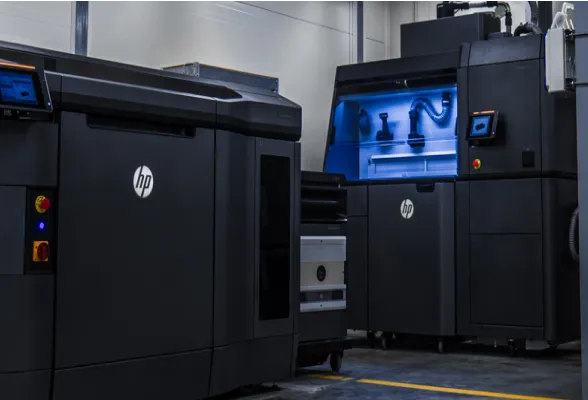FDM (Fused Deposition Modeling) is the most common 3D printing technology. These filament-based devices can already be found in almost every modern R&D department in the world.
However, in terms of precision and quality of manufactured parts, this is a very imperfect technology. Moreover, due to low production capacity, these printers are only used in prototyping.
MJF (Multi Jet Fusion) technology is a much newer solution on the market, especially compared to FDM. The printers debuted in 2016 and it quickly became clear that they could revolutionize not only the prototyping process, but also the production of innovative devices.
With the high quality and the ability to produce large numbers of parts at once, this solution is already widely used for the production of housings, spare parts and machine elements.
In this article, we will compare both technologies and in what situations it is worth using them.
FDM vs MJF – technology characteristics
First, let’s look at the key parameters of both technologies.
| Characteristic | FDM (Fused Deposition Modeling) | MJF (Multi Jet Fusion) |
| Material | Thermoplastic filaments (e.g. PLA, ABS, PETG) | Mainly polyamide powders (e.g. PA12, PA11) |
| Resilience | Depends on the material; PLA is less durable, ABS and PETG are stronger | Very good, parts are homogeneous and have good mechanical strength |
| Printing precision | The best models on the market achieve an accuracy of approximately 0.1-0.4 mm | Very high precision of +/-0.3mm ≤ 100 mm, +/-0.3% >100mm |
| Printer performance | Low efficiency, only one element can be printed at a time | High, can produce many parts simultaneously |
| The need to use supports | Yes, especially for complex geometries | No supports. Possibility to print very complex geometries |
| Strength on axles | Differences in strength due to the filament feeding method | The same for X and Y |
| Surface finish | Visible layers that require processing for smoothing | Smooth, homogeneous |
| Treatment | Possible smoothing, but rarely used due to its use only in prototyping | Possibility of painting, sanding and dyeing, depending on your preferences |
| Printer price | Depending on the model, from a few hundred up to several thousand € | The latest models start at 75,000 € |
Observing this comparison, you can easily see that these technologies are completely different and were created with completely different applications in mind. HP Multi Jet Fusion printers were created for use in wider production, specialized projects and other advanced projects requiring quality.
These devices are much larger and more expensive than FDM printers. Using them also requires a different approach to design. We often hear that clients come forward with designs created using 3D printing using older FDM technology, and we see further opportunities to optimize these designs, improving their quality and reducing the cost of production.
FDM printers have completely different purposes. These are still indispensable devices supporting R&D departments in the production of prototypes and they can also be used in the production of single parts in emergency situations. At their current prices, they are also increasingly being purchased by home hobbyists, artists and homegrown inventors.
When to use FDM technology?
FDM is an ideal technology in situations where the quality of manufactured parts is not so important. The printers are inexpensive, so the solution is ideal for functional prototyping, allowing engineers and designers to quickly iterate on designs, test product form and function, and perform assembly tests.
The ability to use more durable materials such as ABS and nylon also allows the creation of usable parts such as housings, handles and structural elements. Due to the relatively long printing time and the ability to print only one part at a time, this solution is only possible for very limited needs.
Additionally, FDM is used in education because it is an easy-to-use, safe and relatively cheap technology, which allows students to learn and experiment with 3D printing.
When to use MJF technology?
The capabilities of MJF (Multi Jet Fusion) technology mean that it is used when short-series or serial production of high-quality and precision parts is required.
Due to the quick implementation time, our clients also use this technology in the prototyping process. Thanks to this, designers and engineers can work on fully functional, high-quality prototypes on an ongoing basis, with the certainty that the same features and durability will be maintained in series production.
Thanks to the quality, homogeneous structure and good mechanical strength, parts printed in MJF devices are used in industries such as automotive, medicine, and innovative hardware. Below are some examples of projects we have completed for companies in these sectors:
Medical device housings for Berger & Kraft
Components of a brain activity testing device for Cortivision
Will MJF technology work for your project?
As MJF technology experts with 10 years of experience in implementing projects using these devices, we have no doubts about their potential. However, we realize that this is quite a unique technology that is still not known to many designers, even those who have experience in 3D printing.
With this in mind, in each cooperation we provide full support at the stage of design and implementation of this solution into customer processes. We help answer key questions about what elements can be printed, we help design them and provide the necessary knowledge about the possibilities offered by Multi Jet Fusion.
If you are wondering how this technology can support your project, please write to us.


